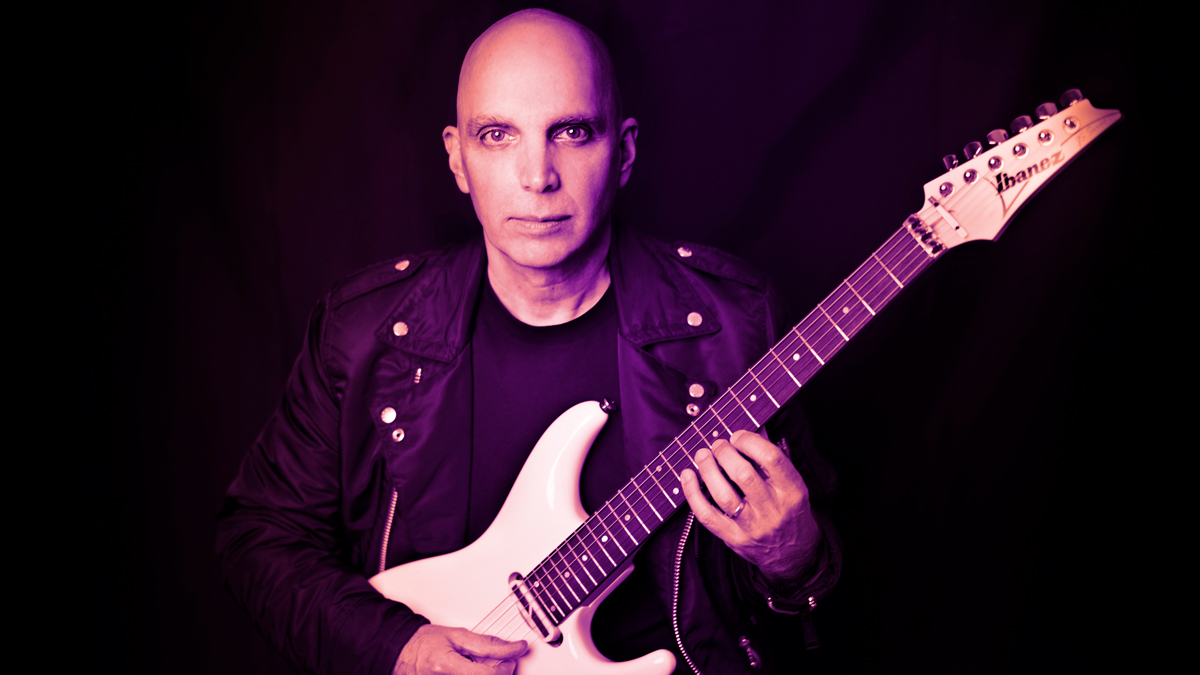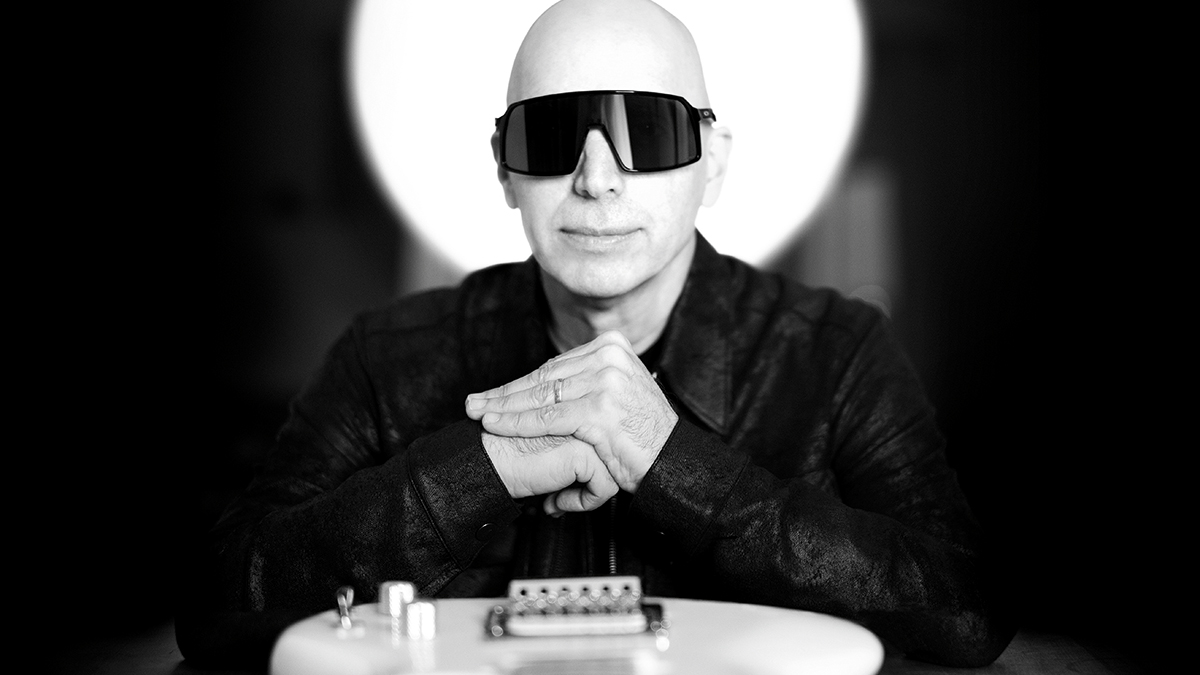Joe Satriani: “I’m not trying to sell myself as a guitar technician. I write songs because I want them to become the soundtrack to people’s lives”
Returning with The Elephants of Mars, the virtuoso king tells us about turning his back on amps, winging it on sitar and what he really thinks of Steve Vai’s triple-neck Hydra guitar

Over lockdown, while the rest of mankind was dealing with earthly concerns, Joe Satriani was looking towards the stars.
“Over the months, this story started to develop in my head,” reflects the virtuoso. “It’s in the future, Mars has been terraformed and Earth’s corporations are raping the planet for raw materials. What they don’t know is that there’s a lifeform there, which is these 30ft elephants. And they’re gonna fight, so Mars can retain its natural beauty…”
As concepts for rock ’n’ roll records go, it’s fair to say The Elephants of Mars is bolder than the time-honoured cars and girls. Fortunately, for the first time in a pacy career that began with 1986’s Not Of This Earth, Satriani had the breathing space to dream up instrumentals every bit as ambitious. “This album,” he says, “was all about removing barriers from my creative impulses.”
You’ve said you’re not impressed by the instrumental guitar scene right now…
“I was misquoted on that! I’m not impressed with the state of my instrumental guitar playing recently. The last couple of albums, I leaned back in time. Especially with Shapeshifting [2020]. It was a down-to-earth record, not futuristic or even present-day sounding. I always felt sad that I missed the classic-rock era. I was too young to be a peer of Page, Beck, all those guys. So the Extremist [1992] was my homage to classic rock and my way of saying, ‘If I were of that generation, this is the album I would make.’
I don’t have to go on Instagram and show people I can play faster than I did yesterday, or go on TikTok and say, ‘Buy my guitar pick!’
“But a year ago, I thought, ‘Okay, I’m finished with that.’ I’m not trying to sell myself as a guitar technician. I’m not 16 years old any more. I don’t have to go on Instagram and show people I can play faster than I did yesterday, or go on TikTok and say, ‘Buy my guitar pick!’
“I write songs because I want them to become the soundtrack to people’s lives. So with The Elephants of Mars, I said, ‘I’m not gonna limit myself. If I want to write something weirdly funky like Night Scene or devastatingly heartfelt like Desolation, I’m gonna do it.’”
Get The Pick Newsletter
All the latest guitar news, interviews, lessons, reviews, deals and more, direct to your inbox!

You recorded this album remotely. How did that change the dynamic?
“It was interesting, the effect of having nobody in the room. It let more dynamic, truthful, creative performances come out. I’m a creature of live performance, which means if there’s even one person there, I’m gonna perform to them. I’ve recorded albums where the band’s all staring at each other, and at the end, I think, ‘Why did I play it like that?’
“With The Elephants of Mars, I kept it spontaneous but, out of 100 performances, I could choose the one that was the most truthful. And I passed that onto the other guys. Like, ‘Take your time and don’t be afraid to throw anything at me.’”
What imagery were you seeing with these instrumentals?
“Once in a while, I’ll write a song like Blue Foot Groovy, which is just about a guy strutting his stuff. But I’m not afraid of taking on subjects that are deeper and more difficult. Y’know, a piece like Desolation or Sahara, which is about someone going through a total spiritual and emotional crisis. It helps guide my composition and, of course, the performances as well because I’m an emotional player. Sometimes I wish I was more professional… but I can’t help it!”
How did the track Desolation translate to the guitar?
“I think Eric Caudieux [producer and keyboards] expected me to just do another solo over that. And that would be the smart thing to do, to play something that no-one else can play on top of it, right? Y’know, make a name for myself in the guitar world. But I wasn’t moved to do that. I thought, ‘No, this is a song about someone who knows they’re dying and also the person who’s sitting there saying goodbye.’ It’s two different perspectives.
“I honestly didn’t know how to play it without making it all wrong. So I’d come in the studio, put it up and just improvise. Let myself be totally emotional about it. When it didn’t work, I’d just turn off, come back the next day – until the moment happened.”
Every guitar sound you hear was recorded direct and we used a SansAmp plugin. That’s insane. If you could see this room I’m in, it’s filled with great amplifiers – and I didn’t use any of them
You’ve said you tried some “crazy ideas” on this album. For example?
“Well, the craziest idea was something that goes against everything I’ve spent my whole career developing. Every guitar sound you hear was recorded direct and we used a SansAmp plugin. That’s insane. If you could see this room I’m in, it’s filled with great amplifiers – and I didn’t use any of them.
“I mean, we tried. But every time we put one against the other, the SansAmp version won. Luckily, I don’t have a deal with Marshall any more, but I had to call my friends over at IK Multimedia and say, ‘I’m really sorry, but that’s just how it turned out…’”
How much of a departure was that?
“It’s not the first time I’ve recorded without speaker bottoms – I did Engines Of Creation [2000] that way. But it was the first time I’ve used plugins. We had every intention of just re-amping everything like we’ve done for the past 20 years. But it really surprised me. It’s far more dynamic.
“I can’t tell you how many times I’ve recorded a wonderful performance where you can literally hear my fingertip on the string – and then you go in the studio and either play it again through an amp or re-amp it, and you feel let down. You sometimes feel there’s a rule, like, you can’t use a plugin. But in the end, we went, ‘Hey, this sounds better.’ So we went with it.”
Does that mean you’re done with regular guitar amps?
“No. I’ve got a whole bunch of them and as I do every day, I’m gonna turn ’em up and practise for the tour that’s hopefully coming. I love dealing with amps. But playing live with an amp has nothing to do with recording an album.”
What do you think are the most striking guitar moments?
“Well, I never do that. Because I’m the worst person at guessing what is going to strike someone. A fan was once telling me about The Extremist and what my vibrato on this high note meant to them. I would never have picked that out – I’d have picked out the fastest bit or some screaming harmonic – so that reminded me that I’m the person who makes the music but not the one to tell people what to like.
“When I was recording my eponymous album in 1995, [producer] Glyn Johns said, ‘Joseph, it’s not your job to decide what people will like. It’s your job to play your bloody guitar!’ It was a great way of lifting all that anxiety off my shoulders.”
Greg Koller actually had Les Paul’s very own 1176 limiter that he ran all my guitars through
Well, if you can’t pick favourite tracks, can you choose favourite tones?
“I’m a guy who likes to take risks. So the long solo section in the title track – that’s one take. I plugged into a Palmer signal splitter and an Electro-Harmonix Micro Q-Tron, and said, ‘I’m gonna record in stereo all at once, just rock it out and see what happens.’ And I just went for it.
“There were technical issues because the Q-Tron, even though you think it’s gonna be 100 per cent effected, it gets confused, so every once in a while it turns itself off for a microsecond then back on again. But it was fun for everybody to react to the insanity of that guitar sound. It does sound like a herd of elephants.”
Were there any new effects pedals on your ’board?
“Very few. I had the TC Sub ’N’ Up, but I’m looking on the floor right now – I haven’t cleaned up yet – and I didn’t use any others besides my wah-wah. Delays, flangers and phasers were all done with plugins, or Greg Koller [mixer and masterer] may have used outboard gear. He actually had Les Paul’s very own 1176 limiter that he ran all my guitars through.”
Your Ibanez obviously still does the business. But don’t you miss going in guitar shops and browsing?
“I do. I used to spend two days a week at Bananas At Large across the Golden Gate Bridge. But in the last 15 years, I went from being an avid collector to finally realising I wasn’t interested. I only have a few vintage pieces left and I rarely play them.
“It’s a no-brainer because, technically, my JS has everything I like: the scale, access, frets, woods, electronics, pickups, bar. I still love an old Tele, Strat, Les Paul, all that. But I play them to step outside of my zone. If a track needs a Strat, I’ll play it. But I know that’s not really my instrument.”
What do you want out of a humbucker now, and how has that changed?
“I think it’s about what you’re plugging into. When I started out, amps didn’t have a lot of gain. I remember, I brought my ’68 Tele into Charles LoBue’s shop in Manhattan and met a young Larry DiMarzio, who was working for Charles and doing what everyone was calling the ‘Staten Island’ pickup. He put one in my Telecaster and that was the beginning of me starting down that road of supercharging the guitar to drive the amp.
On this album, 99 per cent is just three JS guitars, and they all sound different – super-clean and chimey, or super thick and crazy
“But then people realised we were missing a lot of the subtleties of the guitar because the pickup was too loud. Eventually, I said, ‘Look, I just want the widest signal possible for what’s happening on that fretboard.’ So that’s what got Larry to develop the Satchur8. I’ve found it to be the most versatile pickup.
“Right now, I’m looking at my signature Marshall JVM, a ’71 Plexi, an original 5150, a new EL34 EVH amp, Fender Deluxes, Princetons… and when I plug my JS guitars into all those, the amps come through full-character. It’s not making every amp sound like the pickup, y’know? So on this album, 99 per cent is just three JS guitars, and they all sound different – super-clean and chimey, or super-thick and crazy. But the main thing is that the pickup does not interfere with what’s happening between my finger and the string.”

Your legato is fantastic as ever. What advice can you give?
“I have to practise a lot. I’ve always found that guitar playing is difficult for me. So I practise legato slowly and I practise faster than I can pull it off. But I also focus for shorter periods. So instead of practising for hours on the same thing, I’ll do something for 20 minutes and not do it again until eight hours later.
“That’s really helped me, with the body I’m dealing with. I’m tighter than I should be in general. When I was a young athletic person, it was difficult for me to stretch the way my teammates could. And as a young guitar player, I’d have tension issues. So I had to figure out how to absorb this mountain of knowledge, and practising in sections really helped.”
Do you ever write things that prove impossible live?
“When you have a phrase, you have to investigate how many different ways you can play it. When we put out Shockwave Supernova [2015], I entered into a really bad phase of tension with the little finger of my fretting hand. It was because of that title song. When I was writing it, I figured out all the different places to play it and came up with one version that sounded unique – but my hand didn’t want to do it live. It started to really hurt.
When we put out Shockwave Supernova, I entered into a really bad phase of tension with the little finger of my fretting hand. It was because of that title song
“That tour, I had to rewrite so many fingerings. I’d sit down before a show and figure out, like, which notes had to be legato or could I pick three of them instead? When I got off tour, my chiropractor discovered I was just tight and solved my issue in a week. Once in a while, you write something you probably shouldn’t have written [laughs].”
Do you play Surfing With The Alien differently these days?
“Oh, I play it much better now. When I recorded that song, the main melody and the solo at the end were done very quickly, under duress. [I was] in a studio I was being told I had to vacate, with a Kramer that was going out of tune.
“I remember saying, ‘Just give me two more minutes!’ The solo section is far more precise now. The thing you can never really get better is anything to do with feedback or screaming notes. Those things are once in a lifetime.”
Be honest: what do you think of Steve Vai’s new triple-neck Hydra?
“Oh, it’s so perfectly Steve. Just when you think Steve has reached the height of his insanity – which is directly related to his immense talent – he takes it one step further. Now we just gotta figure out how he can play it live without hurting his shoulder.”
You play sitar on Doors of Perception. Do you rate yourself?
“Yeah, that’s a Jerry Jones electric sitar. I love the sound – but, boy, they really take over a track. I owned a ‘real’ sitar for many years. One of my students, his family owned an Indian restaurant and were getting rid of a sitar they had in the window. I tried playing that for years and just sitting cross-legged on the ground for an hour’s practice was hard enough. So thank God for six-string sitar emulators.”
Finally, do you believe there is life on Mars?
“I’m sure there is life on Mars, but it’s probably nothing to do with what we think of as aliens. I think there’s more chance that aliens look like elephants than ET…!”
- The Elephants of Mars is released via earMusic on April 8.
Henry Yates is a freelance journalist who has written about music for titles including The Guardian, Telegraph, NME, Classic Rock, Guitarist, Total Guitar and Metal Hammer. He is the author of Walter Trout's official biography, Rescued From Reality, a talking head on Times Radio and an interviewer who has spoken to Brian May, Jimmy Page, Ozzy Osbourne, Ronnie Wood, Dave Grohl and many more. As a guitarist with three decades' experience, he mostly plays a Fender Telecaster and Gibson Les Paul.
Guitar World Discussion: Who is the most underrated guitar player of all time?
Ozzy Osbourne’s solo band has long been a proving ground for metal’s most outstanding players. From Randy Rhoads to Zakk Wylde, via Brad Gillis and Gus G, here are all the players – and nearly players – in the Osbourne saga

















